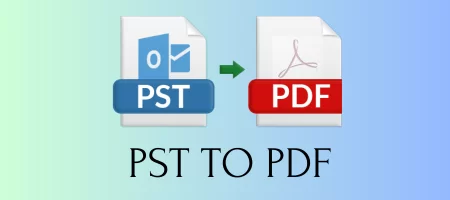Convert PST to PDF
Introduction
If you have ever found yourself needing to share Outlook data or archive important emails, you might have considered converting your PST (Personal Storage Table) files to PDF format. This article will guide you through the process, exploring different methods and best practices to ensure a smooth conversion.
Table of Contents
- Introduction
- Benefits of Converting PST to PDF
- Methods for Converting PST to PDF
- Step-by-Step Guide for Manual Conversion
- Leveraging Outlook's Export Feature
- Exploring Third-Party Tools
- Best Practices for a Smooth Conversion Process
- Overcoming Common Challenges
- Comparing Conversion Methods
- Security Concerns and Data Integrity
- Frequently Asked Questions (FAQs)
- Conclusion
Benefits of Converting PST to PDF
Enhanced Accessibility
One of the main advantages of converting PST to PDF is the improved accessibility it provides. PDF files are universally readable across platforms, ensuring that your data remains accessible to recipients no matter what device or software they use.
Security and Confidentiality
A higher level of protection is provided by PDF files, which let you encrypt the content and manage access with passwords. This is essential to securing private information because it ensures that only those with authorization have access to the content.
Compatibility Across Platforms
PST files are primarily related to Microsoft Outlook, however PDFs are usable with basically any device and operating system. Due to its cross-platform connectivity, PDF is an excellent option for sharing and archiving. PST files are primarily connected to Microsoft Outlook, yet PDFs are usable with almost any device and operating system. Because of its cross-platform interoperability, PDF is an excellent option for sharing and archiving.
Methods for Converting PST to PDF
By the way, there are many ways to convert PST files to PDF. But each method has its advantages. They are usually detected in three ways. The manual conversion method can be leveraged by exporting the file through Outlook and using third-party software.
Step-by-Step Guide for Manual Conversion
Opening Outlook and Locating PST
- Open Microsoft Outlook.
- Go to the "File" tab and select "Open & Export."
- Choose "Import/Export" and select "Export to a file."
- Click on "Outlook Data File (.pst)" and proceed.
Exporting PST to CSV
- Select the PST file you want to convert.
- Choose the destination for the exported file.
- Select the desired options for duplicate items.
- Complete the export process.
Converting CSV to PDF
- Open the exported CSV file using Microsoft Excel.
- Save the Excel file as a PDF document.
- Your PST data is now in PDF format.
Leveraging Outlook's Export Feature
Accessing the Export Option
- Open Microsoft Outlook.
- Navigate to the "File" tab.
- Click on "Open & Export" and select "Import/Export."
Choosing PST Items to Export
- Select "Export to a file" and click "Next."
- Choose "Outlook Data File (.pst)" and click "Next."
- Select the PST items you want to export.
Selecting PDF as the Output Format
- Choose a location for the exported file.
- Specify options for handling duplicate items.
- Choose "Adobe PDF" as the export format.
- Complete the export process.
Exploring Third-Party Tools
Benefits of Using Third-Party Converters
Third-party tools offer convenience and additional features, such as batch conversion and advanced settings. They are often user-friendly and can save you time compared to manual methods.
Top-rated Tools in the Market
- Tool A: Known for its speed and accuracy.
- Tool B: Offers a user-friendly interface and customizable settings.
- Tool C: Ideal for large PST files and maintains folder hierarchy.
Best Practices for a Smooth Conversion Process
To ensure a seamless conversion experience, follow these best practices:
Backup Your PST File
Before initiating the conversion, create a backup of your PST file to prevent data loss in case of unexpected issues.
Choose the Right Conversion Method
Consider the size of your PST file, the level of security required, and your familiarity with the chosen method when selecting a conversion approach.
Check for Data Accuracy
After the conversion, carefully review the PDF file to ensure that all data, including attachments and folder structure, is accurately preserved.
Overcoming Common Challenges
Large PST Files
For large PST files, consider using third-party tools that are optimized for handling extensive data efficiently.
Password-Protected PST Files
If your PST file is password-protected, ensure that the chosen conversion method supports decrypting and converting secured files.
Maintaining Folder Hierarchy
Choose a method that explicitly mentions maintaining folder hierarchy to prevent disorganization in the converted PDF.
Comparing Conversion Methods
Time Efficiency
Manual conversion may take longer, especially for large files, whereas third-party tools often offer faster processing times.
Cost Considerations
While manual methods are typically free, third-party tools may have associated costs. Consider the value they bring and weigh it against your budget.
User-Friendliness
For those less familiar with technical processes, third-party tools with intuitive interfaces may be preferable over manual methods.
Security Concerns and Data Integrity
Encryption and Decryption
Ensure that your chosen method supports encryption and decryption to maintain the security of your data throughout the conversion process.
File Compression
Consider tools that offer file compression options to reduce the size of the PDF without compromising quality.
Ensuring Data Accuracy
Verify that the conversion method preserves data accuracy, especially in terms of email content, attachments, and folder structure.
Frequently Asked Questions (FAQs)
-
Can I convert a password-protected PST file to PDF?
- Yes, some third-party tools support the conversion of password-protected PST files.
-
Is there any free tool available for PST to PDF conversion?
- Some tools offer free versions with basic features, but advanced functionalities may require a paid subscription.
-
How long does it typically take to convert a PST file to PDF?
- The duration varies based on the size of the PST file and the chosen conversion method. Third-party tools are generally faster.
-
Will the folder structure be maintained during the conversion?
- Yes, most conversion methods, especially third-party tools, ensure the preservation of the folder hierarchy.
-
What are the potential risks of using third-party conversion tools?
- Risks may include data security concerns and compatibility issues. Always choose reputable tools and read user reviews.
Conclusion
In conclusion, converting PST to PDF opens up a world of benefits, from enhanced accessibility to improved security. Whether you opt for manual methods or third-party tools, make sure to prioritize data accuracy and security throughout the process.
Comments
Other News

Virtual DJ Keyboard Shortcut Eject Deck

Microsoft Office 2021 Torrent Risks and Alternatives





